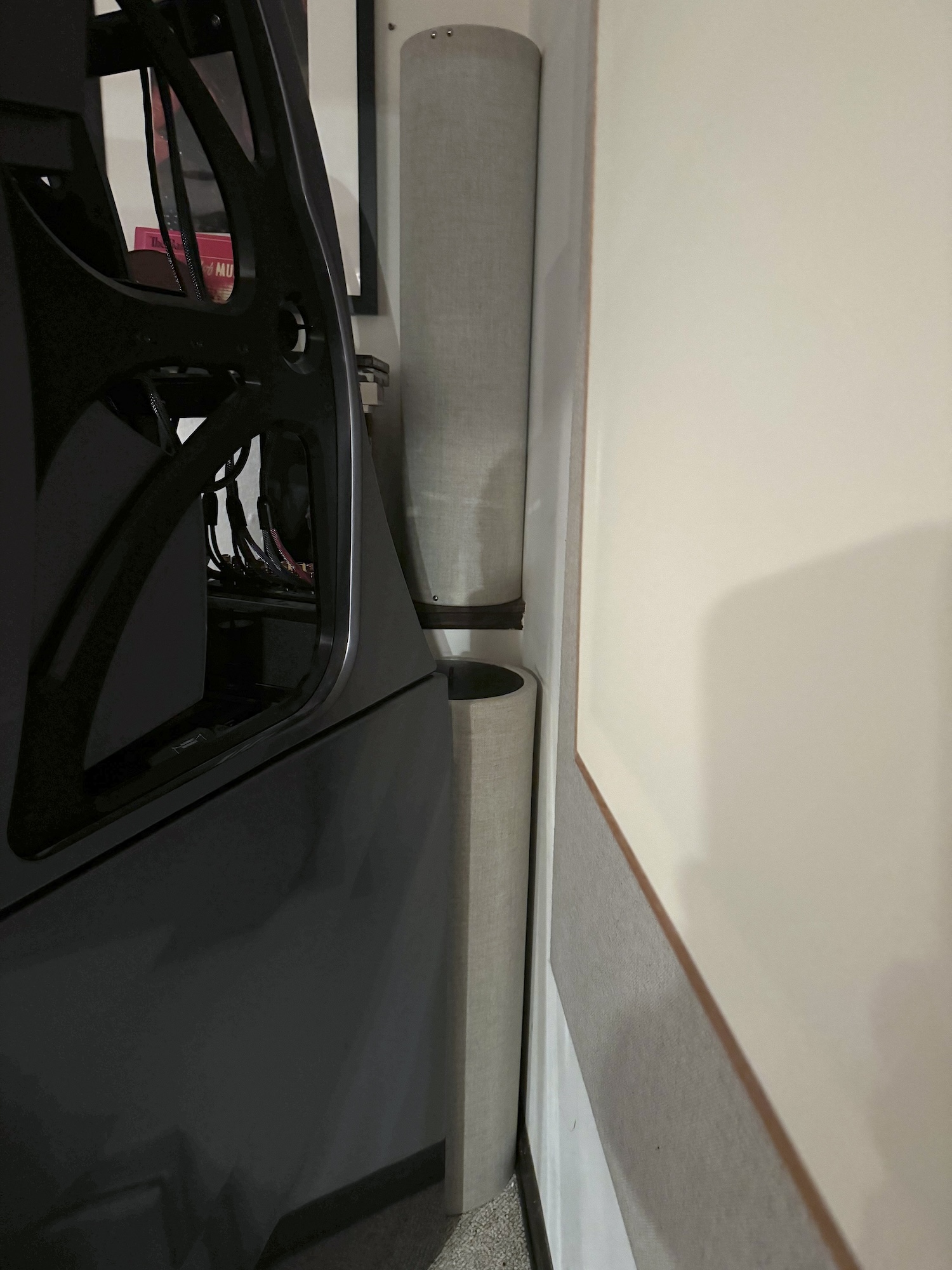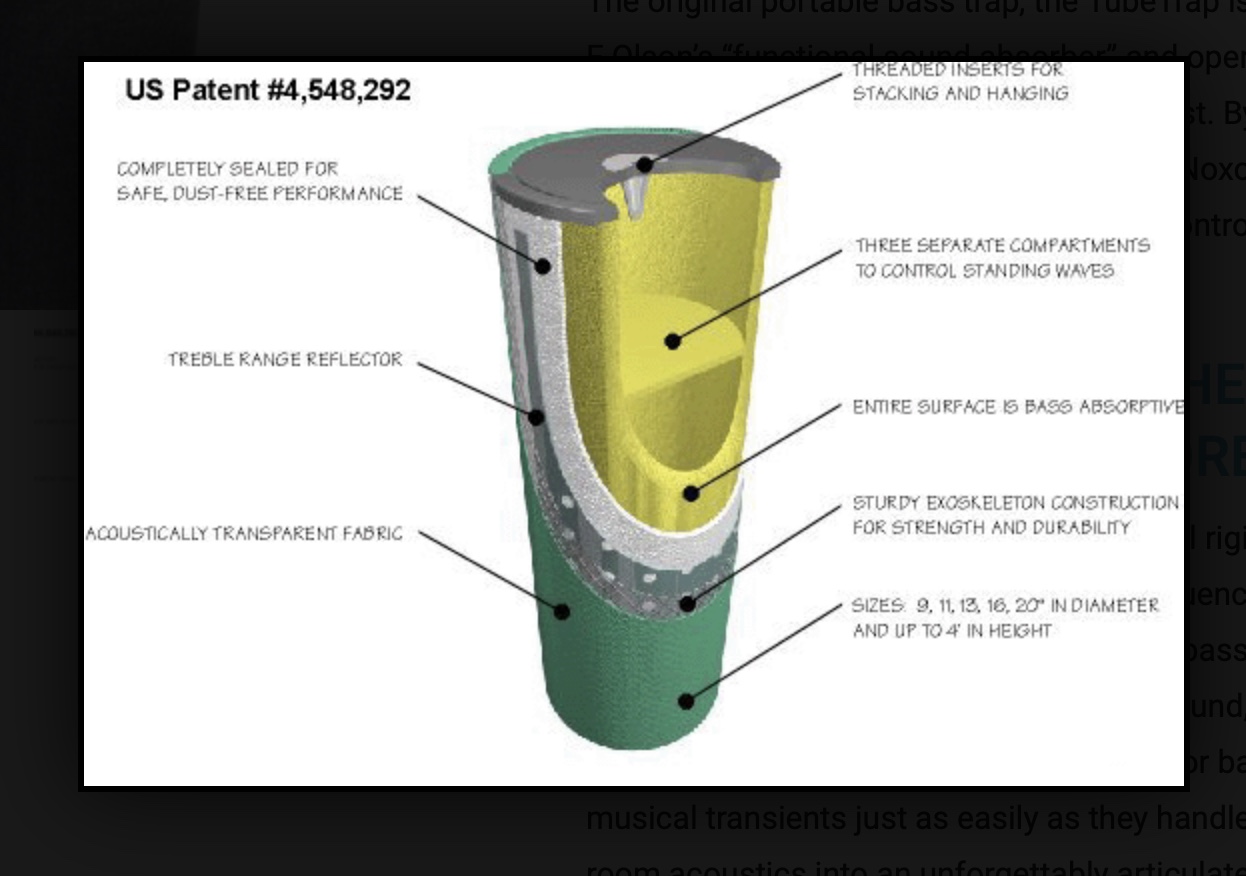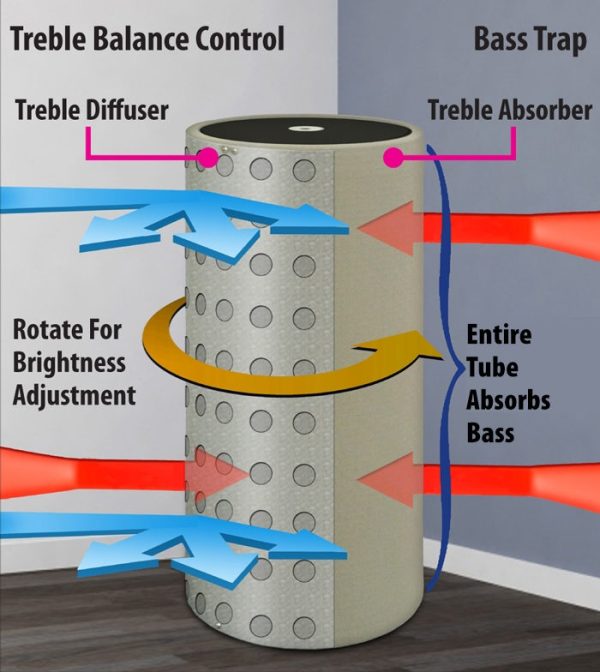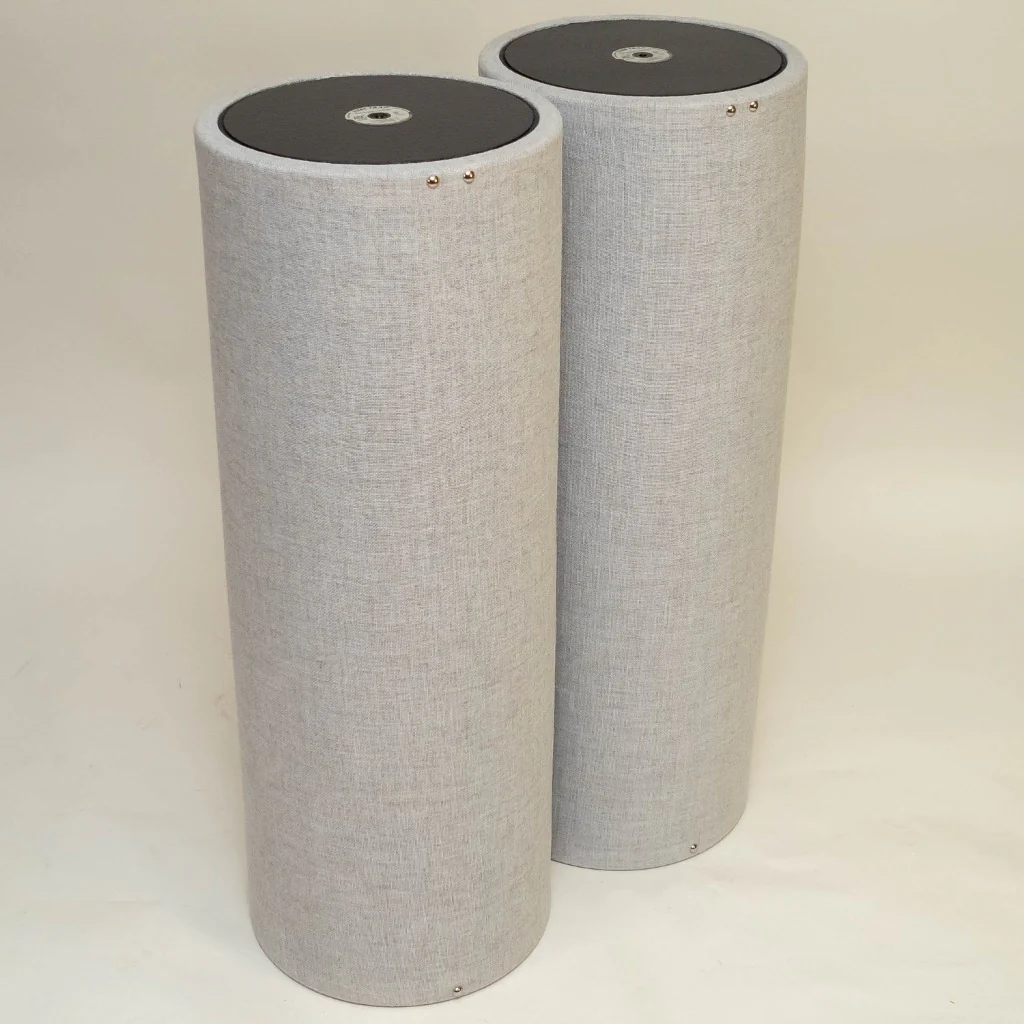ASC Tube Trapped For Life!
Don't be home without them
Two recent connections provided the perfect opening for this review. One was from a guy I'd not heard from in more than twenty five years. He'd visited my basement listening space but I don't recall the circumstances. Contacting me via LinkedIn, he wrote, "I don’t think I’ve ever heard a system and room as gorgeous as your Glen Rock room. Not the recording studios I’ve been in. Not the radio station rooms I’ve broadcast from in years past. I can’t image how you can top that. I remember you showing me the ceiling in which the Japanese couple created holes to improve the sound. What an amazing day that was and yes, the Beatles never sounded like THAT before. Hope you are doing well my friend!"
Of course, that basement room was hardly gorgeous and it had a relatively low dropped ceiling among other issues that I successfully countered. It was plebeian by any definition but worked remarkably well. I've been in many knock-out gorgeous rooms throughout the world and that one was not among them! I recall one in Bangkok with rows of angled theater seating that could accommodate at least a hundred listeners and another with a balcony, where you could experience Belafonte at Carnegie Hall from either Parquet ground level or approximately first tier height. As for the holes that improved the sound, it's too long a story but it had to do with Rayleigh waves and holes poked in the dropped ceiling panels and baseboards by a visiting Japanese gentleman that "evened out" the room sound and that's all I'm going to say about it, other than that he'd treated Carnegie Hall's rehearsal space.
I responded that my current room, where I've been since 1999, was far superior sounding and the equipment on another level of great. He responded, "It’s hard to imagine how much better it can get. Maybe with a bigger space than the Glen Rock basement you might be able to get better imaging and larger scale dynamics but that GR basement was so dead quiet that the spaces between notes were silent. The dynamics in that room were sublime." For a "move in as is" room, the sound was quite good.
I had a premonition in the winter of 1999 that i needed to get out of the Glen Rock house. I didn't know why but I had to get out. I told my wife we had to move. She said "No" and I said well I'm going and I'm serious. So she went along. We went home shopping and I looked at the rooms that would be the listening room, applauding in each to get a primitive idea of the room acoustics. The real estate people asked why I was applauding rooms.
There was no science behind the room I ended up in. I just hoped it would work out because it was "promising", but as many of you have no doubt found out, there are no guarantees! The current room is not large—about 15x20 with a long hallway entrance that's almost like a speaker port but it has a taller eight foot ceiling and also has a cement floor. Not as large a room as I'd hoped for, but among its excellent features I figured, was that it's not a basement but rather the lower level of a bi-level house, which means it's only partly below ground level and so the cinderblock foundation rises part way up from the floor—about 41 inches— with everything above being standard sheet rock/stud framing on the front wall behind the speakers—hard/soft. The side walls are partitions into rooms on either side. If you want to see the opposite of this haphazard approach, watch TAS editor Robert Harley describing how he built a listening room 'from scratch'.
In the video Robert refers to Acoustic Science Corporation's Art Noxon, who is both a physicist and an acoustician. In case you're unfamiliar:
"Art Noxon is a fully accredited Professional Acoustical Engineer with Master’s degree in both Mechanical Engineering (Acoustics) and Physics. He invented the TubeTrap in 1983. He created Acoustic Sciences Corp in 1984 to manufacture and distribute the TubeTrap. A prolific inventor, he has 12 TubeTrap related patents and has developed over 150 other acoustic devices and counting. A scientist, lecturer, writer, and teacher of acoustics, Art Noxon has presented numerous AES papers, magazine articles, white papers, lectures and classes in the field of applied acoustics." In other words, Noxon is more scientist than businessman/marketer/promoter.
Noxon developed a special stud/sheetrock interface that eliminates sheetrock/stud contact—something Harley employed in his build. I promise you that while coincidentally the house I bought was built by a guy named Kuzma (and Franc says no doubt he's related), Noxon's invention is not behind the sheetrock here! But behind my Wilson Audio Specialties Chronosonic XVX speakers are four not visible, hiding behind the speakers, "vintage" ASC Tube Traps.
The other gentleman who contacted me has never visited. He found me on YouTube and after seeing my room convinced himself that it could not possibly work. He listed the reasons and insisted I hear his room (etc.). Of course the Tube Traps are hidden behind the speakers in the YouTube videos that he watched but they are here (these are the new ones reviewed here):
 Normally you'd stack a same sized set to reach from floor to somewhere near the ceiling. TubeTraps can easily be screwed together. But my corners have the aforementioned ledge, which produces two corners in each corner. The larger diameter Trap sits on the floor, the smaller one on the ledge.
Normally you'd stack a same sized set to reach from floor to somewhere near the ceiling. TubeTraps can easily be screwed together. But my corners have the aforementioned ledge, which produces two corners in each corner. The larger diameter Trap sits on the floor, the smaller one on the ledge.
The four TubeTraps I have been using until the new ones arrives for review were given to me in 1987 by The Absolute Sound's founder Harry Pearson and they've been in my system in all four living spaces I've occupied since moving back from the west coast. These old ones have seams in the cloth covering that tell you how to orient the traps relative to the "built in treble range diffuser to back scatter and diffuse the upper treble range back into the room and to also enhance development of fine-grained lateral ambience in the room". I've always oriented them to maximize this feature.
As for the premonition I had: we moved in June of 1999. In September Hurricane Floyd hit the area. Though my new home sits at the bottom of a hill and water cascaded for hours like a river down the hill directly behind my listening room, the water miraculous made a ninety degree left turn, exiting the lower patio level parallel to the house, flowed out to the driveway and then exited to the street.
My listening room remained dry but the Glen Rock basement was inundated with three feet of sewer water that flowed out of the lower level bathroom adjacent to the listening room. Had we stayed in that house, my record collection and audio system both would have been severely damaged or destroyed and of course probably to this day would be smelling pretty foul. Whew!
TubeTraps
These cylindrical devices are bass trap diffusers that convert large wavelength sound energy to heat through friction. The great part about writing web reviews is that rather than regurgitating to you the explanation found on the ASC website, I'll just provide a link where you can read all about how these cylindrical devices work. What's there is science-based not hyperbolic audiophile "snake oil" talk. But this paragraph is worth repeating here:
"Bass range room gain comes from the horizontal and vertical components of the spherical bass wave front emanating from the speaker and their multiple reflections off the floor, ceiling and side walls in the front of the listening room. Each musical event produces some sort of sustain that often lasts 1/8th second or more. During that time, the sonic wave front travels 140 feet, which is across the room 9 or 10 times and vertically over 15 times. This causes a rapid increase in stored energy and sound level in the front of the room which slowly expands out into the rest of the room, engulfing the listener in a wave of nonsensical sound that is a replica(s) of what the loudspeaker just played. This unwanted sound energy blurs the rapidly changing sound level (and musicality) contained in the source material. To maximize enjoyment of your music or accuracy of your mixing, this blurring must be controlled. Enter scene: bass traps."
 You'll find a TubeTrap history on the ASC website that makes for interesting reading and there you'll find that Noxon's efforts had an antecedent in work done by the legendary RCA engineer/acoustician Harry Olson though at the time he devised his, he was unaware of Olson's work.
You'll find a TubeTrap history on the ASC website that makes for interesting reading and there you'll find that Noxon's efforts had an antecedent in work done by the legendary RCA engineer/acoustician Harry Olson though at the time he devised his, he was unaware of Olson's work.
I've never not had these in my system because the first time I tried them, the improvement was so noticeable why would I not use them? But for the purposes of this review, I removed all four and what I heard didn't really surprise me. When the four were in the corners I didn't hear the space at the front of the room or the room at all (I thought). Despite what the impossible "giant speakers stuffed into room corners" situation looks like, that's not at all how it sounds.
in fact, a team of acousticians did visit here some years ago and after a very serious analysis the graphs of which I'm not permitted to reproduce, the conclusion was "We feel your room’s acoustics are actually fairly well behaved and better than we often see when measuring listening rooms, but there is always room for improvement."
With the four original TubeTraps removed it wasn't as if all of a sudden bass was wild and out of control and overwhelming, but rather that the area adjacent to and behind the speakers all the way to the wall was now audible as a sonic "add on" to the music. No doubt had my room not been otherwise well-treated, that sonic "add on" would be audible throughout a much greater area within the room. Tube Traps removed, it became an audible blurring more than "boomy bass", in which the music emanated from an ever present cave-like space wherein the musical elements operated with diminished focus, clarity and vibrancy. It wasn't so pronounced that a first time visitor would hear anything amiss, but they'd surely hear the difference with the Traps in place and once heard, no one would want them taken out because there was no "trade-off" involved.
Visitors unfamiliar with excellent imaging almost always point to the dartZeel amps between the speakers and exclaim, "Are those the center speakers?" Why? Because the "phantom" center channel sounds so real, well-focused and solid. With the TubeTraps removed, along with them went the solidity and the sensation that the speakers and the room had disappeared, replaced by the venue—outdoors, concert hall, or recording studio.
I like to play for people live outdoor recordings like The Newport Folk Festival, 1960-Vol. 1 (Vanguard VSD-2087) or Newport Folk Festival-1963 Vol. 2 (Japanese Vanguard SH114). Close your eyes and you're outdoors. You can almost smell the air. It's a great and solid illusion. With the TubeTraps out, the room is there to interfere with the illusion. John Lee Hooker sings "Maudie" while pounding his foot on the stage. With the Traps in, the "pop" of Hooker's foot stomp is clean, punchy and well-focused: fast, yet rounded attack, little sustain and delicate decay. It sounds just like what it is: a guy stomping his foot on a lively stage. Just before removing the Traps I played Soular Energy (Analogue Productions APJ-268-45) featuring The Ray Brown Trio.
Traps out, the Hooker performance lost its "lightness of being" with the foot stomps mildly exciting the space behind and between the speakers and making the room space impossible to not hear and the outdoor sense seriously diminished. The differences were more obvious on Ray Brown's bass, with each pluck having an imprecise, somewhat bloated attack followed by ill-focused sustain and rhythmic sogginess, though none of this was grossly worse than with the Traps in, but it was just sloppy enough to kill the light rhythmic "touch" and seriously damaged the sense of a seamless reality of a soundstage appearing in the space and the speakers not 'sounding'. The room is, after all, otherwise fairly well treated and of course filled with records, a wall of which acts as an effective diffuser.
When Art Noxon sent the new TubeTraps he asked for room photos. I sent separate front and rear photos that he put together to fully appreciate what was happening. He responded with this:
"One thing to note is the density and distribution of treble range sound scattering things throughout the room. Another is the racks and racks of records, each in an its album cover. This provides a huge amount of acoustic back pressure and acoustic friction, which greatly helps to grind the bass energy down in the back of the room.
"Also, you have a section of record laden shelf, in one spot with one orientation, and then another section of laden shelf in another, sometimes with a narrow open space between, this is essentially a random matrix of large bass absorbing wall sections interspersed with bass vents. The result is bass diffusion, diffractive diffusion, bass waves bending around shelf corners into vent pass throughs changing directions = bass diffusion. Then I think you have some open doors, as least one, that also vents bass but this time out of the room into adjoining spaces.
"Your room is an organic calliope of acoustics complimenting the sound system. Self-made, from the inside out, a 'design' evolved out of need to receive, to store and retrieve, without regard to any other regimens. Essentially a masterpiece that wasn't designed but evolved out of need (italics mine)." "An organic calliope of acoustics". I like that!
In other words, I lucked into an unlikely room that works well and out of record storage necessity and other room features, unknowingly created "a masterpiece". Who knew? Well, actually I knew, because that acoustician had measured and told me.
New TubeTraps In
New Traps in (same size as the old ones), I went upstairs for dinner. Back downstairs, rather than playing any of the above records to hear the differences I figured I was sure to hear, I decided on an evening of "I'm going to play what I want for fun, including selections I've not played for far too long, and to hell with reviewing".
I oriented the traps with the upper treble range diffusors aimed into the room. The new Traps feature shiny metal caps to identify the treble range diffusor area.
The first record was a U.K. original of Squeeze's East Side Story a "Porky Prime Cut" that smokes the original A&M American edition. I'd played it within the year and using the same gear currently in the system. Immediately clear was that not only was the "cave" gone, and the front of the room returned to its previous bottom octave clarity or maybe better, but the upper bass region had been "de-misted", kiln dried, "transparent-ified" and finely focused to a degree I'd not heard before in this room!. A layer of upper bass "clog" that I didn't know was there, was gone!
Something had definitely changed. The duo of Chris Difford and Glenn Tilbrook do octave singing. That is, they sing the identical parts octaves apart, with Difford plumbing the depths. I've never heard them so perfectly delineated and easily followed, tune after tune. I can't remember which tune, but I heard a piano part that had been buried way back in the mix now of course still buried way back in the mix but with each ornately conceived note clearly delivered and effortless to follow.
Then it was on to an original British Polydor pressing of Blind Faith, which is a much better album than many people say it is and again the focus and resolve and detail emerging from a region that had been in the mist of space and time, hiding in plain "sight", effortlessly presented itself coherently and stayed together at far higher SPLs than I figured the room (and my ears) could comfortably handle. I found, record after record, that I could turn up the volume and not lose any detail or focus and that overloading the room was now (within SPL reason) impossible.
My gobsmacked thought was "This is like a major overall system upgrade", almost like moving into a larger, and improved listening space and after days of this I'm sticking with that conclusion. The improvement in clarity, focus and a fundamental sensation of relaxation and improved spatial focus was major, not at all subtle.
I could go on for pages, describing all of the familiar records I played since that first evening and how they'd been sonically improved, but I think you get the point. I'll just add that solo piano recordings and large symphonic ones produced even greater improvements in unraveling complex musical passages than did the rock and jazz recordings, perhaps due to the complexity of the music, especially at those lower frequencies and I found I could see clearly way farther into the soundstage, and discern greater detail.
"ASC must have seriously upgraded or updated the TubeTrap" I figured because the original ones did similar things but not up this high in range or as effectively. The truth is, I didn't know I'd unboxed and installed four of the new IsoThermal Tube Traps. I just unboxed and installed because they looked very similar to the old ones.
 According to the website "IsoThermal TubeTraps are an improved TubeTrap that provides double absorbing power in the sub-bass range, below 60Hz and enhanced bass absorption up through middle C, or 260Hz." In other words, everything on a piano keyboard from middle C down, is now affected. No wonder I immediately heard an improvement.This graph shows the increased efficiency and effectiveness of the new IsoThermal TubeTrap and that's what I heard.
According to the website "IsoThermal TubeTraps are an improved TubeTrap that provides double absorbing power in the sub-bass range, below 60Hz and enhanced bass absorption up through middle C, or 260Hz." In other words, everything on a piano keyboard from middle C down, is now affected. No wonder I immediately heard an improvement.This graph shows the increased efficiency and effectiveness of the new IsoThermal TubeTrap and that's what I heard.
Best of all, the new Traps are far more efficient so the 13" IsoThermal trap equals the efficiency of the standard 16" trap. In my situation I can't squeeze in anything larger than a 13" trap so the new trap lets me obtain greater efficiency. For those with more space, you can replace older traps with bigger newer ones that will upgrade performance even further. How these new Traps work is explained here.
Warning: if you visit the website you'll be confronted by so much good and useful information about room acoustics, well-explained and devoid of hype, you may stay there for hours.
As for 2019 all TubeTraps have been upgraded to the IsoThermal versions, though you can still special order the original. I'm not sure why anyone would want to do that after what I've heard here. Best of all, these are not expensive! A two pack of 13"x3' Isothermal TubeTraps like the ones I installed cost $1,178. I could not find the smaller diameter TubeTraps on the website, but in most applications approximately $2400 will get your corners covered and once you hear the differences you won't want to be home without them.
Features:
ISOTHERMAL TUBETRAP: TREBLE DIFFUSER AND IMPROVED BASS ABSORBER
New patented technology bass trap with ~2x bass absorption (below 60hz) over our original TubeTrap
Add to existing system or can be used as a standalone solution
Adjustable room ambience and bass reverberation control
Adjustable treble diffusion and broadband absorption
Floor standing and stackable with sturdy exoskeleton
STURDY CONSTRUCTION
Durable, long lasting
Welded and woven steel exoskeleton
Spill/stain resistant texture-lacquer finish
EASY SETUP REQUIRING NO INSTALLATION
Free standing / Floor Standing
Simple adjustment; rotate or pick up and move!
Additional hardware can be use for mounted installations
ADJUSTABLE DIFFUSER
Improved soundstage imaging: depth, clarity, localization and stability
Increased spaciousness
Increase musical clarity and dynamics
Maintains ambience
BASS TRAPPING
Next Gen Bass Absorption from IsoThermal technology
Controlled reverberation and room modes
Reduces mid-bass mud
Turn “room boom” into a tight musical bass line
Improved signal to noise ratio, allowing higher playback levels without coloration and distortion
Specifications
frequency 63 125 250 500 1000 2000 4000 8000
sabins/unit 4.6 9.9 10.7 9.2 7.2 5.5 5.0 5.1
(In acoustics, the sabin [or more precisely the square foot sabin] is a unit of sound absorption, used for expressing the total effective absorption for the interior of a room)
Manufacturer Information
Toll Free: 800-ASC-TUBE











































